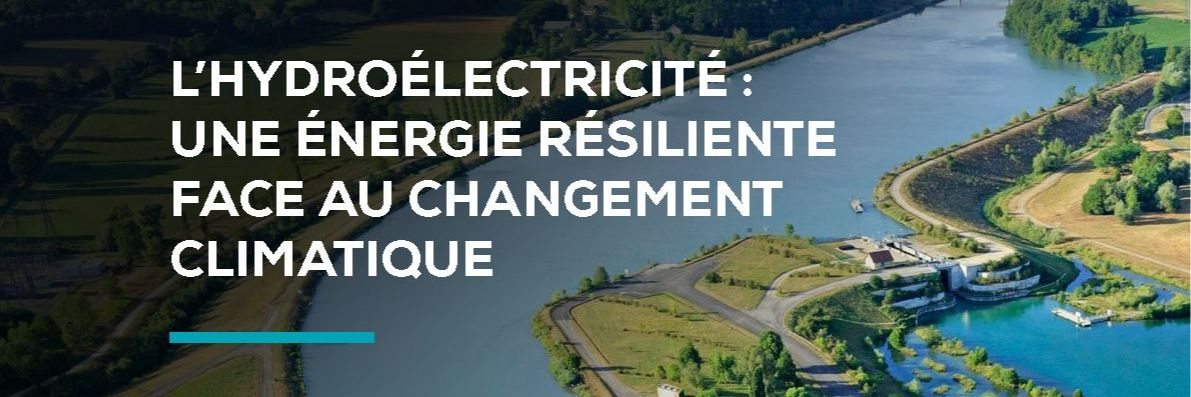News

SER report : Hydropower: a resilient energy in the face of climate change
10 April 2025
Hydropower
Published by
Valentin MAILLOT
Viewed 901 times
In March 2025, the Syndicat des énergies renouvelables (SER) published the report "Hydropower: a resilient energy in the face of climate change".
In this publication, SER provides some answers to these questions:
- What is the impact of climate change on water resources?
- What are the effects of climate change on hydroelectric power plants? On their production?
- Are the facilities adapted to the consequences of climate change?
Points to remember
Flow trends
- Global warming will increase winter rainfall by +20% (between +10% and +45%). Rainfall is higher in the north and lower, or even uncertain, in the south. Year-to-year variability remains high: dry or very wet winters are always possible. Conversely, it will decrease in summer: -25% (between -50% and +5%). Summer accumulations are highly variable from one year to the next: very dry or wet summers are always possible.
- Atmospheric warming will also increase evapotranspiration (evaporation from open-air water surfaces such as reservoirs, and transpiration from plants under the effect of heat). Thus, for an identical volume of precipitation (rainfall), more intense evapotranspiration will lead to a drop in the quantity of water "available" for groundwater and river recharge. The effect of this phenomenon will be particularly noticeable in summer, and will help to amplify the effect of lower summer rainfall on water flows.
- Melting glaciers will temporarily increase river flows until 2040, then reduce them until they stabilize at 1980 levels. In the intra-annual period, snowmelt begins earlier, under the influence of higher temperatures. Peak flows occur earlier in the year, and are also lower due to a spreading effect.
- Prospective studies conclude that average annual river flow remains stable over most of France, but is declining in the south-west. On the other hand, modelling predicts a drop in low-flow rates, with lower levels over longer periods, an increase in the number of dry rivers in summer, and higher, less predictable flood flows over the course of the year.
Environmental impact
- Partial or even total drying-up of certain watercourses, leading to significant mortality of various species (fish, aquatic vegetation, etc.) and to the concentration of pollution modifying the biological and physico-chemical balance of the water.
- High water levels and flooding cause displacement of aquatic fauna and increased mortality, leading to changes in habitats, water quality (pollution) and oxygen availability. Affected environments can take several years to return to equilibrium.
Hydroelectric generation
- High inter-annual production variability (+/- 20% around the average value over the last 30 years)
- Changes in the regulatory framework (in particular, the increase in instream flow since 2006 and the framework for ecological continuity in 2014), as well as the development of water uses, are the determining factors behind the observed drops in production. The industry estimates that the effect of regulatory changes alone represents a loss of around 2% of total annual hydroelectric production.
- Power plants don't turbine very low flows, partly because their turbines need a minimum flow to operate, but also because they have to let a minimum flow through the watercourse to support aquatic life (instream flow). As a result, many power plants are already shut down during the summer months. Under these conditions, the drop in low-water flows has relatively little impact on hydroelectric production. Thus, in lowland and southern France, where flows will fall all year round, whatever the season, hydroelectric production will fall, but by a much smaller proportion than the fall in flows.
- In the mountains, production will increase for around two decades due to glacial melt, before decreasing with the gradual disappearance of the glaciers.
- EDF estimates that, for its hydroelectric fleet as a whole, the average loss of production due to climate change over the next decade will only be around 2% compared to the current situation (i.e. an average loss of 0.2% per year).
The role of hydropower in adapting to global warming
- During periods of flooding, hydroelectric schemes can store water to reduce flows downstream, thereby helping to limit the impact on people and property.
- By storing water when inflows are high, hydroelectric reservoirs can release it during periods of drought, thus ensuring a minimum flow in rivers. This is crucial not only for maintaining biodiversity, but also for ensuring the continuity of important human uses such as drinking water supply, irrigation, cooling of industrial sites and leisure activities.
- When rivers become very hot, releasing water from reservoirs can help lower river temperatures, thereby preserving ecosystems.
- Facilities (canals, reservoirs) can provide refuge for wildlife during periods of extreme summer drought, as was observed in 2022, for example, when many rivers were completely dry.
- Antagonism between environmental and energy needs, which calls for an integrated vision, arbitration and compensation mechanisms: flood control requires reservoirs to be built up during periods of high inflow, while low-water support requires water to be released in summer. However, the value of hydropower for the electricity system lies in the fact that it can draw on large reserves (i.e. full reservoirs) to generate power during peak consumption periods, which generally occur in winter, thus avoiding the need to call on fossil-fired generation resources.
Work to be carried out on hydroelectric power plants
- Increase turbine operating flexibility, or add lower-power units to handle lower flows at low water levels
- Increase reservoir capacities to store rainfall from more extreme events: sites may be suitable for raising dams, or increasing their filling frequency by pumping water.
- Improve the efficiency (ratio between electrical energy produced and water energy available) of installations. E.g.: replacing the turbine and injectors on unit 9 of the Grand Maison hydroelectric power station (Europe's largest dam, which alone accounts for 9% of EDF's hydroelectric power) should boost installed capacity by 10%.
- Over-equipping sites whose potential is not fully exploited (head and/or flow).
Developing the potential of hydropower
- We often hear that France has exploited all of its hydroelectric potential, but this is not true. The French Climate and Energy Strategy (SFEC) proposes to develop the sector's capacity by 2035, with an installed capacity of 2,800 MW compared to 2022. (i.e. 1.7 times the capacity of the Flamanville EPR2). This would represent a 10% increase in French hydroelectric capacity (currently 25,460 MW installed).
- Extract from the PPE3, the consultation for which ended on April 5: " The PPE 2 set the objective of initiating steps to develop STEPs with a potential of 1.5 GW, with a view to commissioning facilities between 2030 and 2035. With this in mind, a public consultation was launched in spring 2023 to determine the economic framework conducive to the development of STEPs and the possible need for public support. This work is continuing, and may be implemented in particular during the award procedure for the new concession for the Lacs Blanc et Noir WWTP in the Hauts-Rhin region, for which an award procedure is currently being prepared. In addition, in January 2024, a rider to the Saut-Mortier concession approved the new STEP project, with a pumping capacity of 18 MW, to develop the energy flexibility of the Ain hydroelectric chain (450 MW) and better reconcile uses around the water resource ". (Reference for the STEP des Lacs Blanc et Noir: this was the first "station de transfert d'énergie par pompage" (Step) in France. This first construction was destroyed by a catastrophic flood on January 4, 1934. A waterspout killed nine people and caused considerable material damage. A new power station was built, but it too ceased operation in 2002, following a breakdown. Shut down until 2008, the concession was taken over a year later by EDF, which dismantled it and undertook to rebuild, but nothing was done, and the utility even decided to abandon the concession. The consultation process launched in 2023 should lead to commissioning in 2030.)
- As part of its energy planning work, the French Ministry of Energy Transition updated the study on the hydroelectric potential of French rivers in 2022, and identified almost 11 TWh of additional power - equivalent to the consumption of 5 million French people - that could be generated through the construction of new hydroelectric power plants.
 3
3









No comment
Log in to post comment. Log in.